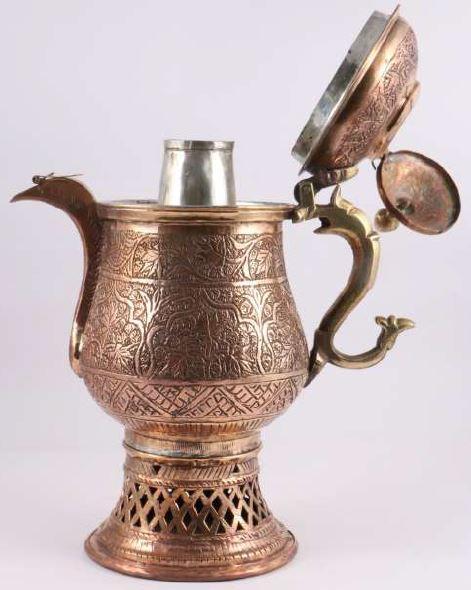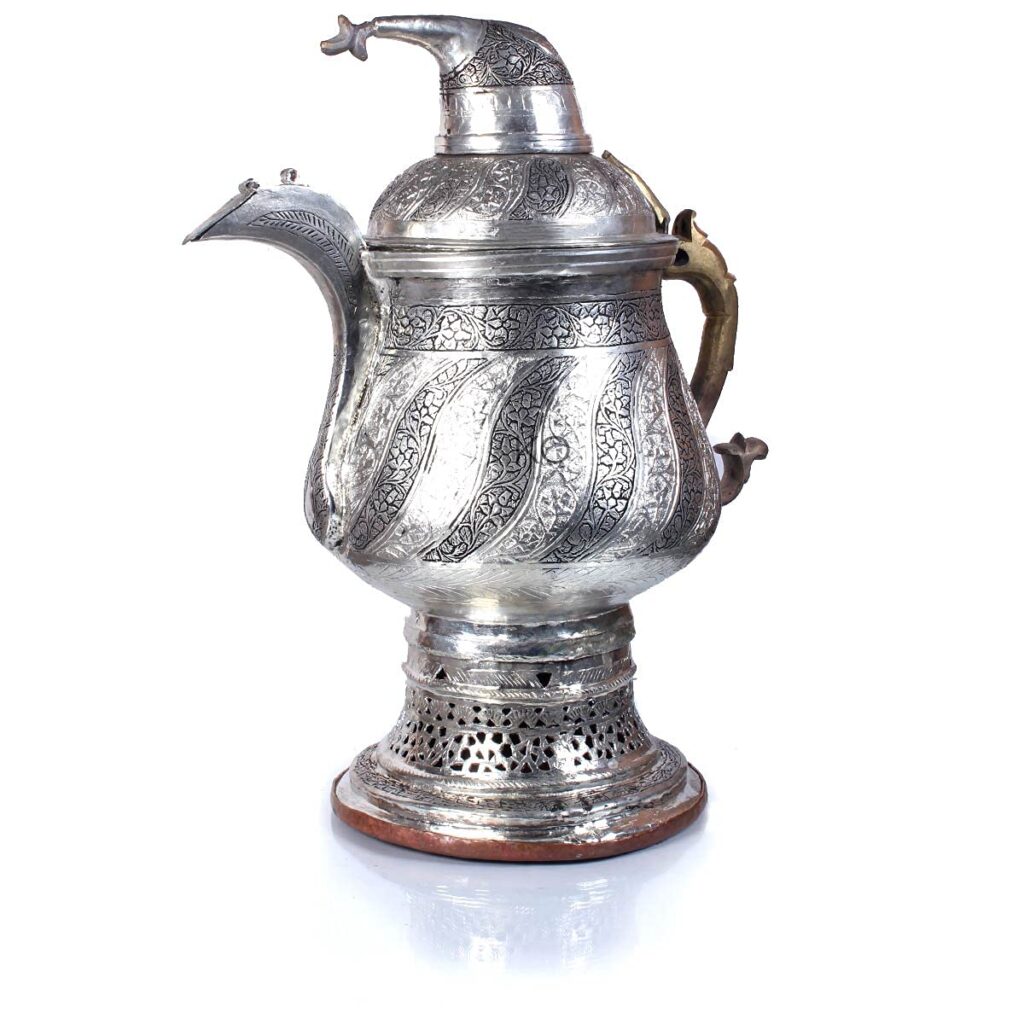
Kashmir, an Indian state nestled in the scenic Himalayan region, is renowned for both its rich cultural legacy and its stunning scenery. The Kashmiri Samovar is a must-have symbol of grace, coziness, and tradition among the many aspects of Kashmiri culture.
What is Kashmiri Samovar?
Kashmiri Samovar is a traditional, sophisticated, and elegant teapot for making and serving tea. Somaa is made of copper and engraved or embossed with calligraphic motifs. Its history dates back to the 18th century when Kashmir was ruled by the Dogra Maharajas. Travelers from Central Asia were the ones who first brought the Samovar to the area, demonstrating the centuries-long rich cultural exchange.
“Samovar” is a word that originates from the Russian word “самоваp,” meaning “self-boiler.” This perfectly expresses the main purpose of the Samovar, which is to brew and heat tea. With time, the Samovar became an essential fixture in Kashmiri homes, particularly in the winter when a hot cup of tea served as more than just a simple rehydration during the chilly months.

Types of Kashmir Samovar
There are two types of samovar in Kashmir.
Brass Samovar: Kashmiri Pandits, a local Hindu community, used brass samovars. Inside, the brass samovars had nickel plating.
Copper Samovar: Muslims used copper samovars
Live coals and charcoal are placed inside the fire container found inside the Kashmiri samovar kettle. There is a place for the water to boil around the fire container.
Design and Art
The Kashmiri samovar kettle is an exquisite example of both design and craftsmanship. It is renowned for its elaborate detailing and intricate hand-etched patterns and is usually made of brass or copper. The distinctive design of the Samovar consists of a central chamber for water heating and a cylindrical base on which the fire is lit. The Kashmiri samovar tea is dispensed via a spout and flue located at the top.
The intricately detailed lotus or peacock motif on the lid of the Kashmiri Samovar is one of its most distinguishing features. In Kashmir, these motifs have deeper cultural and spiritual meaning than just being decorative.
Kashmiri Samovar’s Significance
Beyond its practical use, the Kashmiri Samovar represents hospitality, customs, and communal get-togethers. During special events, the Samovar is the focal point of Kashmiri homes, filling the air with the comforting scent of freshly brewed tea. It is an embodiment of the kindness and generosity that are central to Kashmiri culture.
Making tea from the Samovar and sharing it with others is a ritual in and of itself. Typically, strong tea is made with green tea leaves and sweetened with sugar. A cup of tea is traditionally served with a cube of sugar and a piece of baked bread, or “kulcha,” the traditional bread of Kashmir.
Heirloom Status of the Samovar
In many Kashmiri families, the Samovar is not just a piece of kitchenware; it is a cherished heirloom passed down from one generation to the next. These family heirlooms carry with them the memories of countless gatherings, weddings, and celebrations. They are not just vessels but bearers of tradition and culture.
Cultural Significance of Samovar
The Kashmiri Samovar represents the core of Kashmiri culture and goes beyond its everyday use. It is an important part of many cultural rituals, such as marriages, in which the bride and groom are given tea from the Samovar as a sign of their union and love.
The Samovar has spiritual and religious uses. It is frequently found in mosques and Sufi shrines, where it represents warmth and purity in real life and symbolically. In the Samovar, tea is regarded as a sacred offering.
Craft of Tea Making in the Kashmiri Samovar
Brewing khawa tea in a Kashmiri Samovar is an art in itself. It involves layering the tea leaves with care and letting the water gently boil to give the tea a distinct flavor and aroma.
The tea is often served in small, ornate cups called “Khos” These cups are usually placed within a larger bowl to capture any spillage and to keep the tea warm.
How to acquire a Kashmiri Samovar?
Kashmiri Samovars can be found in traditional markets in Kashmir, as well as through online marketplaces, but before buying you should check the Kashmiri samovar price and design you like. They come in various sizes and designs, so you can choose one that suits your preference.
People also like
-
Are Kashmiri Samovars still being made today?
Yes, Kashmiri Samovars are still being crafted today, although the number of skilled artisans has decreased over the years. Artisans and organizations are working together to ensure the tradition continues by passing down the knowledge and skills to new generations.
-
What are the unique features of a Kashmiri Samovar?
Kashmiri Samovars often feature intricate hand-etched patterns and elaborate detailing. They typically have a lid adorned with lotus or peacock motifs. The Samovar’s unique shape includes a base for fire, a central chamber for water, a flue, and a spout. It is designed to brew and serve tea efficiently.
-
What materials are Kashmiri Samovars typically made from?
Kashmiri Samovars are usually made from copper or brass. These metals are valued for their heat-conducting properties and can be intricately engraved with decorative patterns.
-
How can I maintain a Kashmiri Samovar?
To maintain a Kashmiri Samovar, it should be regularly cleaned with a mixture of lemon juice and salt to retain its shine. Avoid using abrasive cleaners that could damage the intricate designs. Additionally, drying the Samovar thoroughly after each use prevents tarnishing.
Wrap up on Kashmiri Samovar
The Kashmiri Samovar is a symbol of the region’s rich cultural heritage and more than just a teapot. It is the epitome of the hospitality spirit that defines the locals’ culture and is associated with warmth and tradition. Although it may encounter difficulties in the current day, the Kashmiri Samovar’s legacy continues because it is held in esteem by the Kashmiri people as a symbol of grace and hospitality.




